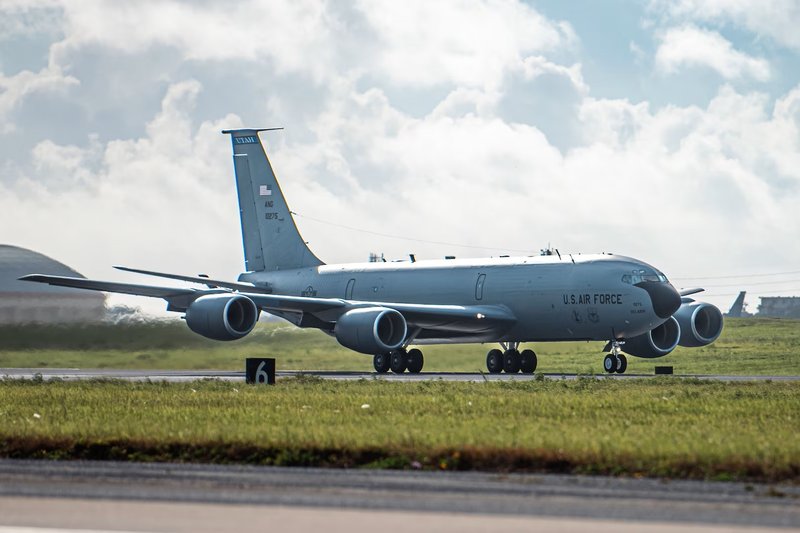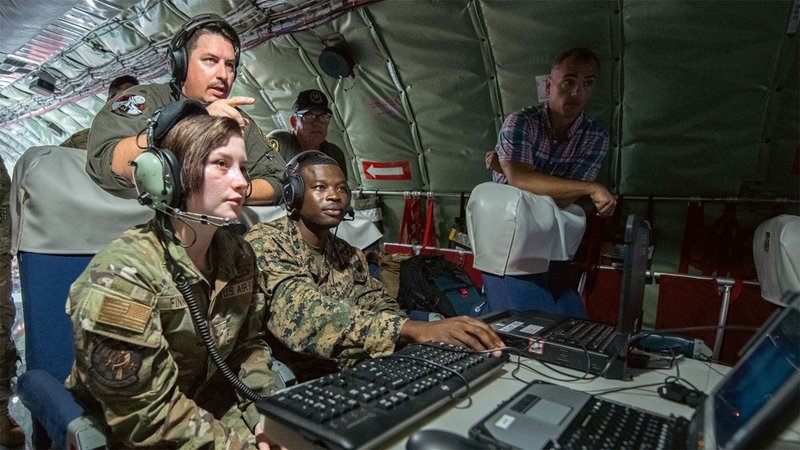Decisive Edge Newsletter | Digital Battlespace | September 2023
Newsletter Sponsor:
Common language: how a UK network protocol is connecting NATO’s anti-drone systems
NATO is on the cusp of adopting the UK’s SAPIENT protocol and new J-series messages for networking the alliance’s deployed counter-UAV assets.
The news comes as NATO brings its fortnight-long Tactical Interoperability Exercise-23 (TIE-23) to a close on 22 September. The TIE series brings disparate sensors, C2 systems and effectors together, with the aim of networking and evaluating these assets in supporting the counter-uncrewed aerial system (C-UAS) mission.

This year’s TIE-23 was held at Lieutenant-General Best Barracks in the southeastern Netherlands. The choice of venue was apt as the facility is home to the Dutch Army’s Joint Ground-based Air Defence Command. Both the army’s Patriot-2/3 medium-range/high-altitude and NASAM-2 short/medium-range surface-to-air missile batteries are based there.
TIE-23 is organised by the NATO Communication and Information (NCI) agency. This year’s event saw participation of several companies from countries across the alliance, all providing C-UAS technologies which were put through their paces in a series of live exercises.
The UK Defence and Science Technology Laboratory’s (DSTL’s) Sensing for Asset Protection with Integrated Electronic Networked Technology (SAPIENT) protocol was central to the effort.
SAPIENT allows data from sensors, effectors (kinetic, electronic and cyber) to be converted into a common language and shared across networks supporting the CUAV mission.
SAPIENT can be carried across standard wired and wireless communications such as deployed tactical radio networks. In December 2021, DSTL published definitions and guidance for building systems and components compatible with SAPIENT.
This approach enables engineers to pre-configure C-UAS systems to be compatible with SAPIENT and hence other systems using the protocol. In February 2023, DSTL published the SAPIENT Interface Control Document, which provides further information on the specifications for SAPIENT-compatible interfaces to enhance connectivity.
The protocol looks set to be adopted as a NATO Standardisation Agreement (STANAG) for C-UAS system networking. The MoD revealed in December 2021 that SAPIENT was under consideration by NATO as a potential standard germane to the CUAV mission. It had already been adopted by the MoD is its standard protocol for networking such systems.
NATO officials told Shephard that the protocol has been under consideration for C-UAS networking by the NCI. Its adoption for this task is now under the scrutiny of 14 NATO nations, who will examine the protocol with a view to its ratification.
Assuming the ratification process moves forward unhindered, it will become a STANAG, receiving a unique number and effectively becoming NATO ‘law’.

Above: NATO’s TIE-23 exercise involved multitudes of anti-UAV sensors, effectors and C2 systems all networked using the SAPIENT protocol, which looks set to become an alliance STANAG for the C-UAS mission. (Photo: NATO)
What this means in practice is that C-UAS systems equipping NATO militaries will be required to be compatible with the SAPIENT protocol, and such stipulations explain why the publicly available documents are important.
Having this information in the open ensures compatibility can be inbuilt into C-UAS systems from the outset. Assuming SAPIENT is adopted as a STANAG, systems already designed with compatibility will already comply with the standardisation agreement. NATO officials are confident SAPIENT could become a STANAG in the next two to three years.
In addition to the adoption of SAPIENT, NATO officials said they expect new C-UAS tactical messaging standards to enter the Link-16 Tactical Datalink (TDL) ‘J-series’ messaging catalogue. Link-16 is routinely used to support air operations. allowing platforms and sensors to share radar track information. It also supports secure voice and data communications.
Alongside this, the TDL handles written J-Series messages. These concern everything from electronic warfare and weapons management to meteorological information. The NATO officials said they expect new J-Series C-UAS messages to enter the Link-16 catalogue in the coming two or three years.
The expected adoption of SAPIENT and J-Series messages represents an important step forward in deepening NATO C-UAS interoperability. The tactical reality is that any deployment of C-UAS assets on the battlefield supporting a NATO operation will comprise assets from an array of nations, which must easily communicate with one another. Moreover, they will need to share tactical information with other NATO assets not immediately involved in the C-UAS fight.
For example, it might be more expedient to use a short-range SAM system to attack a physically large UAV rather than a dedicated C-UAS effector. In such a scenario data regarding the target may initially move around the SAPIENT network.
Once the decision is taken to involve the SAM system, information on the network could be converted to a J-Series message. This message could then be transmitted to the missile battery performing the engagement.
With a successful TIE-23 exercise under its belt, NATO is looking ahead to next year’s iteration which is likely to further deepen the levels of interoperability the alliance has already embraced for the C-UAS mission.
Multiple choices – how the USAF is using tankers as nodes for cross-domain C2
The USAF is moving forward with its adoption of technologies to enhance Multi-Domain Operations (MDO), deploying the Intelligent Gateway link translator and router aboard tanker aircraft during a recent exercise.
MDO is a US DoD doctrinal approach stressing the inter- and intra-force connectivity of all military assets (personnel, platforms, bases, sensors, weapons and capabilities) at all levels of war. Its rationale is to enable a faster and better quality of decision-making to be taken by manoeuvre forces vis-à-vis one’s adversary.

Above: KC-135 tankers spend time loitering at stand-off distance behind strike missions, so are well placed to act as communications relays. (Photo: Air National Guard)
To this end, the DoD is forging ahead with its Combined Joint All-Domain Command and Control (CJADC2) architecture, which aims to federate the strategic, operational and tactical C2 systems of the US armed services to greatly ease the sharing of data between them. Put simply, CJADC2 is the technological manifestation of the MDO mindset.
Each of the services is pursuing an overhaul of its C2 systems and postures to meet CJADC2 requirements, and the USAF’s effort is the Advanced Battle Management System (ABMS).
Integral to the ABMS approach is the ability to easily move data between air force assets. Collins Aerospace’s Intelligent Gateway is one technology underpinning this vision. The Intelligent Gateway was recently put through its paces during the USAF’s Northern Edge exercise held in the Pacific this July.
In a nutshell, the Intelligent Gateway acts as a link translator and router hosting several disparate communications networks. These can include SATCOM and tactical data links (TDLs). Traffic can be moved between networks with the gateway acting as an airborne ‘telephone exchange’.
For example, data traffic may be transmitted across a line-of-sight Link-16 TDL network using frequencies of 960MHz to 1.215GHz. Suppose this traffic needs to be shared with a recipient over beyond-line-of-sight (BLOS) range? It could then be converted into the appropriate protocol by the Intelligent Gateway.
Once converted, traffic is transmitted across a BLOS SATCOM link like the Advanced Extremely High Frequency Ka-band network.
The Intelligent Gateway has been deployed onboard USAF KC-135 in-flight refuellers. Installing the gateway on tankers makes sense; these aircraft tend to spend long periods of time loitering behind strike packages.
As such, they are ideally placed to act as a communications relay. The development of the Intelligent Gateway is ‘helping us frame the idea that tankers can not only resupply fuel, they can also resupply situational awareness by using available space and power to be one of the most connected platforms in the battlespace’, said Elaine Bitonti, VP of connected battlespace and emerging capabilities at Collins Aerospace.

Above: Hardware supporting Collins Aerospace’s Intelligent Gateway is seen here on board a KC-135 during July’s Northern Edge exercise held in the Pacific. (Photo: USAF)
She added that the Intelligent Gateway’s capabilities were enhanced during this year’s Northern Edge exercise. This approach helped break down ‘stovepipes of information so decision-makers at all echelons could process needed information in relevant timeframes’.
Importantly, the gateway showed it could remain connected and share mission data between US and allied participants ‘in automated, secure ways that could survive a highly contested environment’, Bitonti continued.
Collins says that the capabilities underpinning the Intelligent Gateway are currently at Technology Readiness Levels (TRL) Six and Seven. According to DoD definitions, this means they have undergone demonstration as a model or prototype in a relevant environment (TRL-6). TRL-7 denotes they have been demonstrated as system prototypes in an operational environment.
Bitonti added that the ‘technologies shown at Northern Edge will be available for government acquisition and flight operations in the next 12 to 18 months’.
New horizons – who is the UK’s radar on Cyprus sharing data with?
An RAF-operated radar located on Cyprus in the eastern Mediterranean may be sharing its imagery with US and NATO ballistic missile defence systems.
The UK’s PLUTO-II over-the-horizon (OTH) radar is located at the RAF’s Akrotiri air base in southern Cyprus. Open sources say the radar transmits signals on frequencies of between 8 and 38MHz.

Above: This overhead view shows part of the PLUTO-II OTH radar located at RAF Akrotiri, southern Cyprus. The radar is believed to be used for detection and tracking of ballistic missile launches from the Middle East. (Image: Google Earth)
Signals on these frequencies cannot penetrate the ionosphere, the layer of atmosphere between 48 and 965km above sea level.
If radar signals on these frequencies are aimed towards the ionosphere, they will bounce off the atmospheric layer at an opposing angle. This phenomenon lets the radar signals avoid the horizon which can limit a conventional radar’s line of sight and range.
OTH radars are particularly attractive for detecting and tracking ballistic missile launches, as the radars’ properties allow them to detect such launches before the missile’s flight moves above the horizon.
Sources have told Shephard that the PLUTO-II radar deployed to Cyprus can detect and track ballistic missile launches in the Middle East. The region is an area of concern regarding weapons proliferation and the Islamic Republic of Iran maintains a clandestine ballistic missile programme.
Radio amateurs or ‘hams’ have collected several examples of PLUTO-II transmission signals, recordings of which they have made available online. The radio hams say that alongside missiles, the radar may also track aircraft and ships. However, it is most likely that the system is mainly used to detect and follow missile launches.
They say that the radar is likely to have a maximum range of 2,700nm. However, PLUTO-II is at its most efficient when performing surveillance out to a range of 1,890nm – this would place missile launches from Iran well within detection and tracking range.
Coverage is believed to ‘fan out’ eastwards from the radar with areas in Afghanistan, Pakistan and much of the Middle East falling within range.
Sources close to the RAF told Shephard that radar imagery from PLUTO-II may be shared with the US National Missile Defense (NMD) system, which protects the continental United States from ballistic missile attack.
PLUTO-II is believed to be a US-supplied system, although other aspects of its identity remain unknown, such as its official nomenclature and manufacturer. Moreover, the US government is believed to absorb most, if not all, costs of its operation.
In addition to the NMD system, there is every possibility that PLUTO-II shares radar imagery with NATO, which maintains a missile defence capability in the form of its ALT-BMD (Active Layered Theatre Ballistic Missile Defence.
ALT-BMD comprises a network of US-supplied surface-to-air missiles, platforms and radars deployed across Europe to this end. Management of the system is exercised from a NATO command centre at Ramstein, western Germany. Radar imagery could be shared with both the NMD and ALT-BMD systems across SATCOM links.
PLUTO-II is not the first OTH radar the US has deployed to Cyprus. From 1964 an earlier system codenamed Cobra Shoe was installed at Akrotiri. The key difference between PLUTO-II and Cobra Shoe is that the latter was mainly tasked with detecting and monitoring ballistic missile tests from the southern Soviet Union.
Don't want to miss out on future Decisive Edge content? Make sure you are signed up to our email newsletters.











